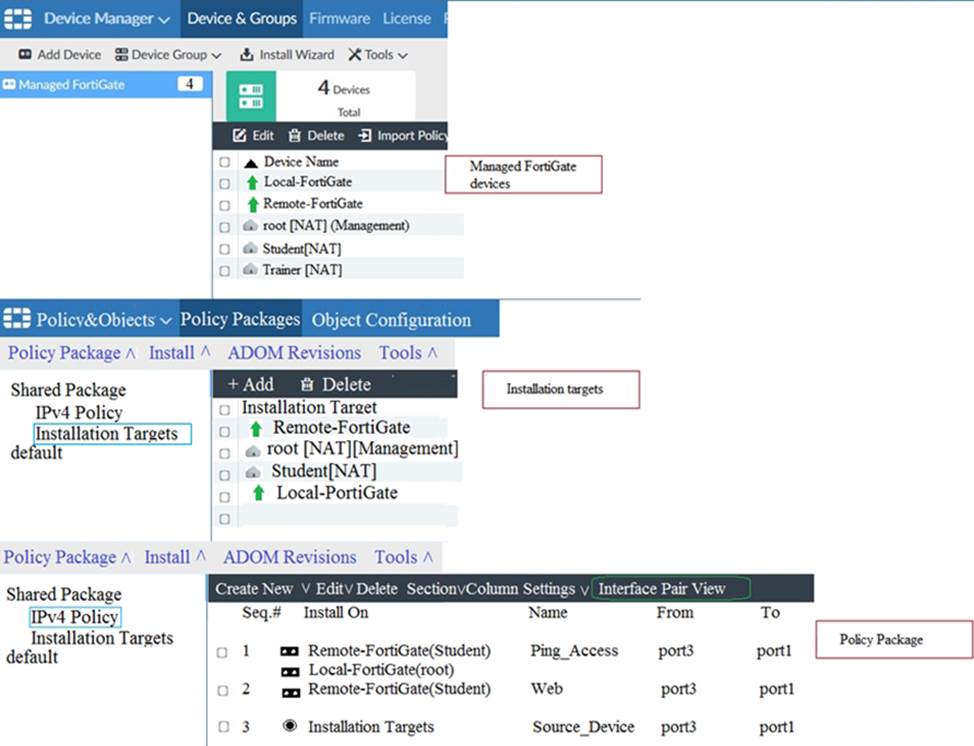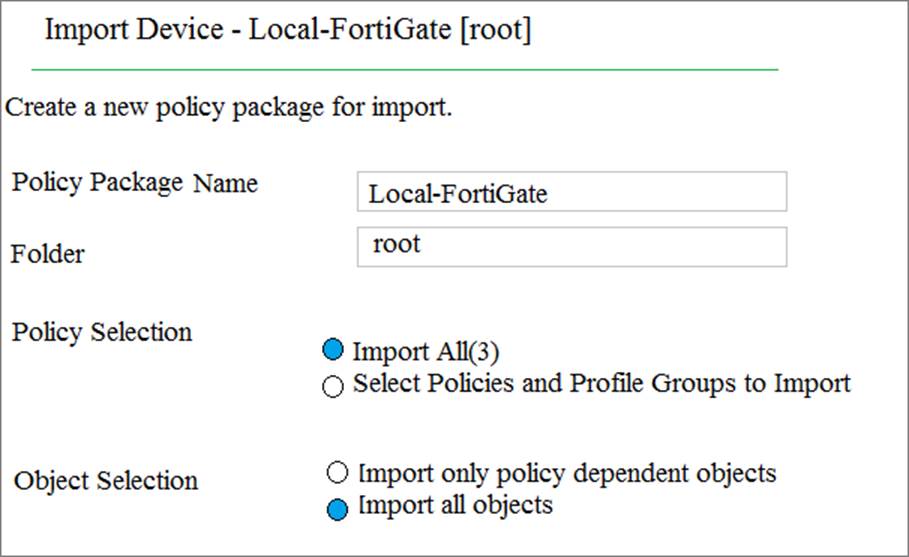Fortinet NSE5_FMG-7.0 Fortinet NSE 5 – FortiManager 7.0 Online Training
Fortinet NSE5_FMG-7.0 Online Training
The questions for NSE5_FMG-7.0 were last updated at Mar 12,2025.
- Exam Code: NSE5_FMG-7.0
- Exam Name: Fortinet NSE 5 - FortiManager 7.0
- Certification Provider: Fortinet
- Latest update: Mar 12,2025
You are moving managed FortiGate devices from one ADOM to a new ADOM.
Which statement correctly describes the expected result?
- A . Any pending device settings will be installed automatically
- B . Any unused objects from a previous ADOM are moved to the new ADOM automatically
- C . The shared policy package will not be moved to the new ADOM
- D . Policy packages will be imported into the new ADOM automatically
C
Explanation:
Reference: https://community.fortinet.com/t5/FortiManager/Technical-Note-How-to-move-objects-to-new-ADOM-on-FortiManager/ta-p/198342
Which two items does an FGFM keepalive message include? (Choose two.)
- A . FortiGate uptime
- B . FortiGate license information
- C . FortiGate IPS version
- D . FortiGate configuration checksum
A,D
Explanation:
The FGFM keepalive message from the FortiGate to the FortiManager includes the uptime of the FortiGate and the checksum of the FortiGate’s configuration. The keepalive message is used to inform the FortiManager that the FortiGate is still online and its current state.
Refer to the exhibit.

Which statement about the object named ALL is true?
- A . FortiManager updated the object ALL using the FortiGate value in its database.
- B . FortiManager installed the object ALL with the updated value.
- C . FortiManager created the object ALL as a unique entity in its database, which can be only used by this managed FortiGate.
- D . FortiManager updated the object ALL using the FortiManager value in its database.
An administrator, Trainer, who is assigned the Super_User profile, is trying to approve a workflow session that was submitted by another administrator, Student. However, Trainer is unable to approve the workflow session.
What can prevent an admin account that has Super_User rights over the device from approving a workflow session?

- A . Trainer is not a part of workflow approval group
- B . Trainer does not have full rights over this ADOM
- C . Trainer must close Student’s workflow session before approving the request
- D . Student, who submitted the workflow session, must first self-approve the request
A
Explanation:
Reference:https://help.fortinet.com/fmgr/50hlp/56/5-6-1/FMG-FAZ/0800_ADOMs/1800_Workflow/0600_Workflow%20sessions.htm
View the following exhibit.

Given the configurations shown in the exhibit, what can you conclude from the installation targets in the Install On column?
- A . The Install On column value represents successful installation on the managed devices
- B . Policy seq#3 will be installed on all managed devices and VDOMs that are listed under Installation Targets
- C . Policy seq#3 will be installed on the Trainer[NAT] VDOM only
- D . Policy seq#3 will be not installed on any managed device
Which two settings must be configured for SD-WAN Central Management? (Choose two.)
- A . SD-WAN must be enabled on per-ADOM basis
- B . You can create multiple SD-WAN interfaces per VDOM
- C . When you configure an SD-WAN, you must specify at least two member interfaces.
- D . The first step in creating an SD-WAN using FortiManager is to create two SD-WAN firewall policies.
View the following exhibit.

An administrator is importing a new device to FortiManager and has selected the shown options.
What will happen if the administrator makes the changes and installs the modified policy package on this managed FortiGate?
- A . The unused objects that are not tied to the firewall policies will be installed on FortiGate
- B . The unused objects that are not tied to the firewall policies will remain as read-only locally on FortiGate
- C . The unused objects that are not tied to the firewall policies locally on FortiGate will be deleted
- D . The unused objects that are not tied to the firewall policies in policy package will be
deleted from the FortiManager database
C
Explanation:
Reference: https://community.fortinet.com/t5/FortiManager/Import-all-objects-Versus-Import-only-policy-dependent-objects/ta-p/193259?externalID=FD40392
An administrator with the Super_User profile is unable to log in to FortiManager because of an authentication failure message.
Which troubleshooting step should you take to resolve the issue?
- A . Make sure FortiManager Access is enabled in the administrator profile
- B . Make sure Offline Mode is disabled
- C . Make sure the administrator IP address is part of the trusted hosts.
- D . Make sure ADOMs are enabled and the administrator has access to the Global ADOM
C
Explanation:
Even if a user entered the correct userid/password, the FMG denies access if a user is logging in from an untrusted source IP subnets.
Reference: https://docs.fortinet.com/document/fortimanager/6.0.3/administration-guide/107347/trusted-hosts
View the following exhibit.

Which statement is true regarding this failed installation log?
- A . Policy ID 2 is installed without a source address
- B . Policy ID 2 will not be installed
- C . Policy ID 2 is installed in disabled state
- D . Policy ID 2 is installed without a source device
An administrator wants to delete an address object that is currently referenced in a firewall policy.
What can the administrator expect to happen?
- A . FortiManager will not allow the administrator to delete a referenced address object
- B . FortiManager will disable the status of the referenced firewall policy
- C . FortiManager will replace the deleted address object with the none address object in the referenced firewall policy
- D . FortiManager will replace the deleted address object with all address object in the referenced firewall policy
A
Explanation:
If an address object is currently being referenced in a firewall policy, FortiManager will prevent the administrator from deleting the address object. This is to avoid potential disruption to the firewall policy’s functionality.
Latest NSE5_FMG-7.0 Dumps Valid Version with 65 Q&As
Latest And Valid Q&A | Instant Download | Once Fail, Full Refund

